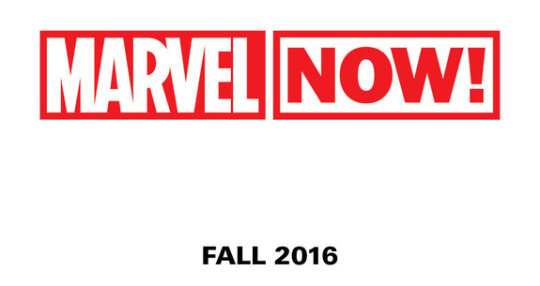
Late last week, Newsarama published this interview with Executive Editor of Marvel Comics, Tom Brevoort. Tom gives us some insight on Marvel’s big publishing initiative coming this fall which he promises will shake the status quo of the comics, and it’s called “Marvel NOW!” Sound familiar? That’s because you may remember the Marvel NOW! relaunches in 2011 and the All-New Marvel NOW! relaunches a couple years later. If it seems that Marvel is has been relaunching many of their series every year or so with new #1 issues, it’s not just you. It is happening. Here are Mr. Brevoort’s major points:
- Marvel has adopted a “seasonal model” for their comics, so many series are indeed relaunching nearly every year.
- Marvel will stick with this model for as long as it’s profitable.
- Not all the comics will relaunch with new #1′s every event, but many will, usually with shifts to the creative teams.
- This is an effort to keep the books consistently “fresh,” rapid, and to avoid downtime in the stories.
There is good and bad here for comic fans. I can see the optimistic side and the cynical side equally. But I want to talk about what these means for us, librarians.
A lot of librarians are simply baffled by comics and have been since libraries began carrying them widespread. Comics are tricky for those who are, to adopt Bane’s word, “uninitiated”. Non-comic reading librarians don’t understand such concepts as floppy monthly issues, trade paperbacks, story arcs, what is or isn’t a “graphic novel”…I could go on and on. And constant relaunches of the books will just make things worse for these librarians, because they often have very little idea what they are looking for, and patrons often don’t know what to ask for.
For example: a patron comes into the library and asks for the first volume of Captain America. This would make some librarians want to pull their buns out and throw their cardigans, especially recently. Which first volume? Just in the past five years, we have had Captain America Vol. 1, All-New Captain America Vol. 1, Captain America: Sam Wilson Vol. 1, and, coming soon, Captain America: Steve Rogers Vol. 1. And let’s not dare look at how many Captain America relaunches there have been since the mid-90s. Does the patron want one of these Captain America Vol. 1′s? Do they want the one from Heroes Reborn? Do they want the original stories from the 30′s and 40′s?
“Please, just tell me!” the librarian wants to scream, as she slowly descends into madness. “Just tell me what you want! Please, just give me a $%&@ ISBN!” And that’s just it: there is a very good chance that the patron may not know what the particular Vol. 1 that they want is even called. Or when exactly it came out. The question might go something like, “I need the first volume of Captain America. It came out a few years ago. It’s the one where he fights the vampire, I think.”
This is a cruel reality for us. And let’s not even mention the multiple meanings that the word “volume” has in comics. It’s horribly complicated. And it doesn’t look it’s going to change. A model like this from Marvel just makes our jobs more difficult, making it more difficult for us to give our readers what they want. Maybe this is exactly why we shouldn’t have comics in libraries.
I’m afraid I have harsh words for you if you are a librarian who thinks this way: Deal with it.
As aggravating as it is, it is not Marvel’s job to worry about libraries. Whether or not it’s easy for us to find a particular comic in our catalog is not going to keep Marvel’s editors up at night. It is not their job to increase our patrons’ access to their materials for free, it is ours. And we have to do it, and we have to play by Marvel’s rules. So what do you do if you are not familiar with comics? How are you supposed to keep up?
- A solid practice is to make the extra effort to familiarize yourself with items that you are not familiar. As best you can, flip through every comic that comes in to your library. Read the blurbs, mind the numbering, and look over the shelves every now and then.
- Pay attention to the year of the item when searching. The patron may not know the year, but it can lead you in the right direction.
- Use Amazon, Comixology, Comic Book Database, etc. Look specifically for the issues that compose that particular volume. Trust me, that info is there, somewhere, in one of those sources. Knowing the issue numbers can help you find synopses of these issues and the plots within.
- Follow sources like Comic Book Resources and Newsarama to track these big Marvel events. You obviously don’t have to read the issues or even know what the events are about, but you should know that potential relaunches are coming.
- Always read the upcoming-comics resources printed by ALA, Library Journal, and other library sources. I mean, duh.
- Do you have an employee that loves comics, but comics aren’t in her job description? Too bad, get her involved and get her input. Also duh.
- Talk to your catalogers. Convince your catalogers that it’s okay to break the cataloging rules and standards (designed for traditional books) to make comics easier to find. For instance, always use the series title as the Title Statement, regardless what’s on the title page. Maybe put the year in the 245 field next to the Title Statement in parentheses?
Take hear and stay strong, non-comic reading librarians. We will get through another Marvel relaunch together! And the next one! And the next one! And the next one…
I’ll be around waiting for the “Marvel $#%& YEAH!” relaunch.
 About Me
About Me